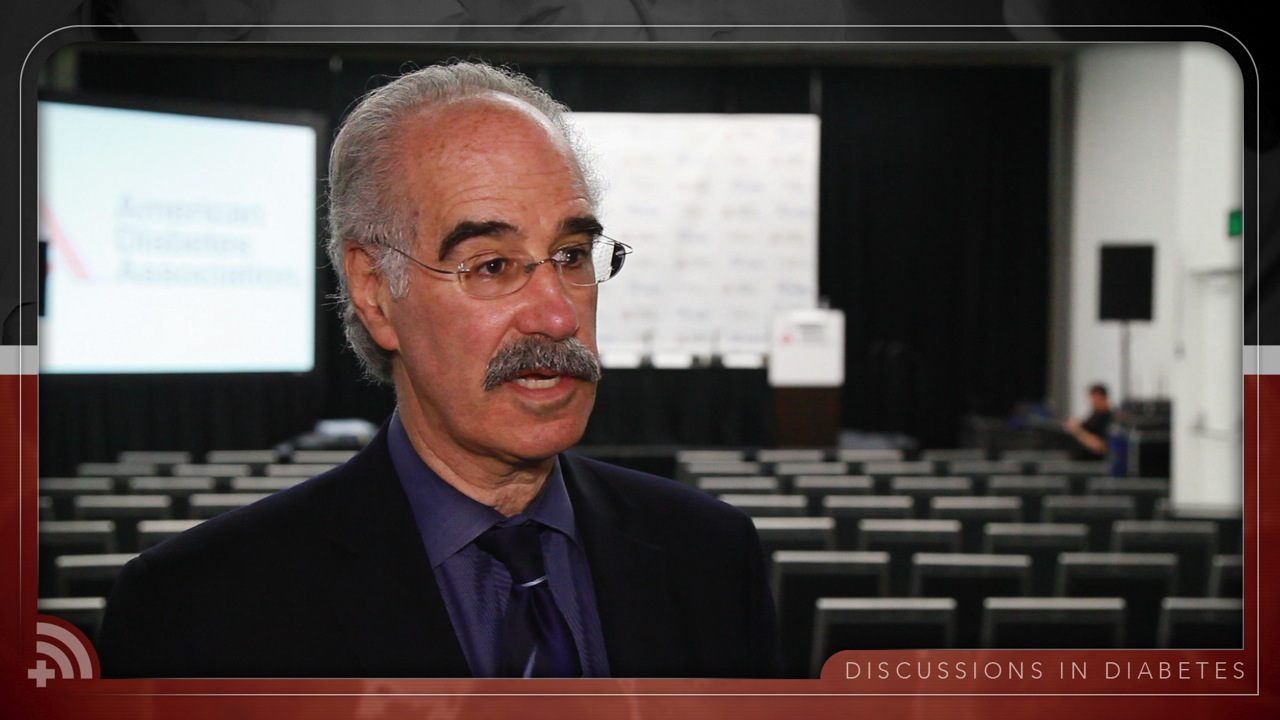Like dapagliflozin, empagliflozin is also approved as an adjunct to diet and exercise to improve glycemic control. The drug's safety and effectiveness were evaluated in 7 clinical trials with 4480 patients with type 2 diabetes. The pivotal trials showed that empagliflozin improved hemoglobin A1c levels compared with placebo. In late 2016, the FDA also approved empagliflozin for a new indiction, specifically, the prevention of cardiovascular disease–related death in adults with type 2 diabetes who also have cardiovascular disease. The new approval was based on results from the Cardiovascular Outcome Event Trial in Type 2 Diabetes Mellitus Patients (EMPA-REG OUTCOME), which included more than 7000 patients.
Kooy et al found improvements in body weight, glycemic control, and insulin requirements when metformin was added to insulin in patients with type 2 diabetes mellitus. No improvement of an aggregate of microvascular and macrovascular morbidity and mortality was observed; however, reduced risk of macrovascular disease was evident after a follow-up period of 4.3 years. These results support continuing metformin treatment after the introduction of insulin in patients with type 2 diabetes mellitus. The care of patients with type 2 diabetes mellitus has been profoundly shaped by the results of the United Kingdom Prospective Diabetes Study . This landmark study confirmed the importance of glycemic control in reducing the risk for microvascular complications and refuted previous data suggesting that treatment with sulfonylureas or insulin increased the risk of macrovascular disease. Major findings of the UKPDS are displayed in the images below.
If you have type 1 diabetes, insulin therapy is vital for replacing the insulin your body doesn't produce. Sometimes, people with type 2 diabetes or gestational diabetes need insulin therapy if other treatments haven't been able to keep blood glucose levels within the desired range. Insulin therapy helps prevent diabetes complications by keeping your blood sugar within your target range. These data emphasize the need to customize therapy to the patient's circumstances and therapeutic goals. Patients given metoprolol were significantly more likely to be started on statin therapy or, if already on statin therapy, to require an increase in the dose, than were patients taking carvedilol. In 2009, the FDA approved a quick-release formulation of bromocriptine mesylate as an adjunct to diet and exercise to improve glycemic control in adults with type 2 diabetes mellitus.
Bromocriptine is a centrally acting dopamine D2 receptor agonist. Indicated as an adjunct to diet and exercise, ertugliflozin therapy is aimed at improving glycemic control in adults with type 2 diabetes. FDA approval of canagliflozin was based on global phase 3 clinical trials that included over 10,000 patients. Adding linagliptin to treatment in patients with type 2 diabetes mellitus that has been inadequately controlled with a metformin and sulfonylurea combination improves glycemic control. In February 2020, the FDA approved dulaglutide for major adverse cardiovascular event reduction in adults with type 2 diabetes mellitus in whom established CV disease or multiple CV risk factors are present.
Although the above results do not support the hypothesis that the GM functions as a postural muscle to control flexion of the thigh during stance when the hip is flexed , they do suggest that the GM has additional functions. One of these functions may be to help actively extend the thigh during stance . Such results are particularly interesting in terms of uphill locomotion. Roberts and Belliveau calculated that hip extensors such as the hamstrings and the GM may not produce much work output during horizontal running, but have increasingly high moments during uphill running. Further studies are needed to assess the contributions of the GM to hip extension during uphill running.
Although the GM has an apparently minor role during walking, several studies have found GM activity to be important in running. The GM was reported to be active at strong to moderate levels at the end of swing phase and during the first third of stance during running(Mann and Hagy, 1980a; Mann and Hagy, 1980b;Montgomery et al., 1984; Nilsson et al.,1985). In addition, it has been reported that GM activity during running peaks near the time of footstrike, and has a similar pattern of contract to the hamstrings (Jonhagen et al., 1996). Unfortunately, only one study has directly compared GM activity in walking and running (Stern et al., 1980), and only in a general qualitative way in one subject. Stern et al. nonetheless found that GM contractions during walking are`minimal' compared to the `considerable' increases in GM activity during jogging and running, particularly in the cranial portions of the muscle(Stern et al., 1980). In a comparison of level versus incline running, Swanson and Caldwell further showed that incline running (30°) at 4.5 m s-1increased the intensity of GM contractions and resulted in an earlier onset relative to footstrike .
However, while EMG analyses of the GM generally indicate a far more important role in running than walking, there has yet to be a comprehensive and quantitative comparison of GM function in both gaits. Dyslipidemia is common in patients with type 2 diabetes mellitus and often takes the form of high triglyceride and low HDL cholesterol levels. Trials have shown that the use of statins is effective for primary and secondary prevention of coronary heart disease events in patients with diabetes. ADA guidelines relating with LDL cholesterol management and CHD in patients with type 2 diabetes mellitus are detailed in the image below.
A new ultralong-acting basal insulin, insulin degludec , which has a duration of action of up to beyond 42 hours, has been approved by the US Food and Drug Administration . This new basal insulin forms a soluble multihexamer after subcutaneous injection to provide a depot effect that is long lasting. A combination product of insulin degludec and the rapid-acting insulin aspart was also approved (Ryzodeg 70/30).
Approval was based on results from the BEGIN trial that showed noninferiority to comparator productions. The cardiovascular outcomes trial comparing cardiovascular safety of insulin degludec to that of insulin glargine in patients with type 2 DM is ongoing. A combination product was also approved that contains insulin degludec plus a rapid-acting insulin . A comparison by Bunck et al of 1 year's therapy with either exenatide or insulin glargine in metformin-treated patients with type 2 diabetes found that exenatide provided significantly greater improvement in beta-cell function. Beta-cell function and glycemic control returned to pretreatment values following discontinuation of exenatide or insulin glargine, suggesting that long-term treatment is required to maintain the beneficial effects of these drugs.
You can control a profile's access to discrepancy review status types and individual discrepancy fields by setting its privileges. By default, a new profile has no update privileges; you must add review status codes, and then discrepancy field values to each master profile. To open the Privileges for DM Master Profile window, from the Admin menu, select Discrepancy Mgmt Admin, and then select Profile Administration. Select a master profile, then click the Privileges button. As noted ,evidence that the human GM and the ape GMIF both act primarily as hip extensors during the stance phase explains much of the derived configuration of human GM anatomy in terms of the reorganization of the human pelvis for bipedalism.
In addition, the ape GMIF and the human GM are both active towards the middle or end of swing phase, suggesting a shared role in swing-limb deceleration. In order to test this hypothesis more fully, however,additional data are needed on the amount of work done by the muscle during hip extension , versus trunk flexion. It would also be useful to assess GM activity during walking and running on uneven substrates, although preliminary EMG data during walking on uneven ground indicates no measurable increase in activity.
Importantly,this relationship is also true during `Groucho' running when peak EMG activity was much lower relative to speed than during normal running(Fig. 7B), but at the level predicted for trunk pitch rate (Fig. 7C). The timing of GM activation also makes sense in terms of controlling trunk pitch rate. Peak flexion of the trunk in a walk occurs after MS as the body's center of gravity is beginning to fall, but in a run occurs at the time of HS. As Hypothesis 2 predicts, the stance-side GM contracts after HS in a walk but before HS in a run, thereby helping the GM extend the hip as the trunk pitches anteriorly. Additional evidence for the GM's role in controlling trunk flexion is provided by the results of the `Groucho' gait trials. This decrease in activity during `Groucho' trials suggests that stabilizing the thigh to counteract flexion is not a major function of the GM.
Instead, decreases in normalized peak EMG magnitudes during `Groucho' trials relative to normal trials are predicted by the strong correlation between maximum trunk pitch rate and GM activation for normal walking and running(Fig. 7C). This result provides strong support for the hypothesis that GM functions largely as a trunk stabilizer during running. However, a randomized, controlled trial from Japan found that using low-dose aspirin as primary prevention did not reduce the risk of cardiovascular events in patients with type 2 diabetes. Although the risk for CHD is 2-4 times greater in patients with diabetes than it is in individuals without diabetes, control of conventional risk factors is probably more important in event reduction than is glycemic control. Control of hypertension, aspirin therapy, and lowering of LDL cholesterol levels are vitally important in reducing CHD risk. Additionally, patients with alcoholism or other serious substance abuse problems and patients with severe, uncontrolled mental illness may be unable to effectively participate in the care of their diabetes.
Consequently, they are at high risk for severe hypoglycemic reactions if near-normal glucose levels are targeted. Dapagliflozin is indicated as an adjunct to diet and exercise to improve glycemic control in adults with type 2 diabetes mellitus. It can be employed as monotherapy, as initial therapy with metformin, or as an add-on to other oral glucose-lowering agents, including metformin, pioglitazone, glimepiride, sitagliptin, and insulin. The 1050 participants in the study had baseline HbA1c levels of 6.5-9% and received sitagliptin or metformin for 24 weeks. Semaglutide SC gained FDA approval in January 2020 for risk reduction of major adverse cardiovascular events in adults with type 2 diabetes and heart disease.
Results from the 2-year randomized study SUSTAIN 6 (Trial to Evaluate Cardiovascular and Other Long-term Outcomes With Semaglutide in Subjects With Type 2 Diabetes) led to approval for the new indication. In the trial, 3297 adults with type 2 diabetes and established cardiovascular disease received either injectable semaglutide or placebo, in addition to stand-of-care therapy. Dulaglutide was approved by the FDA in September 2014 as adjunctive therapy to diet and exercise to improve glycemic control in type 2 diabetes mellitus. It is administered as a once-weekly subcutaneous injection.
Approval was based on six clinical trials involving a total of 3342 patients who received dulaglutide as monotherapy or as part of combination therapy. Dulaglutide was noninferior to daily liraglutide in one study and superior to the oral dipeptidyl peptidase–4 (DPP-4) inhibitor sitagliptin in another. Adverse effects included nausea, diarrhea, vomiting, abdominal pain, and decreased appetite.
These might include the use of antibiotics and antiviral agents, the rate of influenza vaccination and bacterial vaccination, and demographic and social factors. For example, elderly persons in nursing homes are at risk for pneumonia caused by enteric organisms and sometimes by drug-resistant nosocomial organisms. The spread of bacteria such as methicillin-resistant Staphylococcus aureus and highly pathogenic clones of Streptococcus pyogenes pose more general risks .
Primary care providers can care for patients with type 2 diabetes mellitus adequately. The multiple facets of disease treatment and data management must be continually addressed. Kashyap and colleagues demonstrated that bariatric surgery improved glycemic control in patients with type 2 diabetes. At 24-month follow-up, glycemic control improved in all 3 groups.
Body fat reduction was similar in the 2 surgery groups, with patients in the gastric bypass group showing a greater absolute reduction in truncal fat. Insulin sensitivity increased significantly only in the gastric bypass group, and pancreatic β-cell function increased significantly more in these patients compared with those in the other 2 groups. Finally, patients with hypoglycemia unawareness or those with recurrent episodes of severe hypoglycemia should also have high target levels, at least temporarily.
Fortunately, patients with type 2 diabetes mellitus (unlike those with long-standing type 1 disease) usually maintain adequate hypoglycemia awareness. This greatly facilitates hypoglycemic therapy in patients with type 2 diabetes. A study by Siegelaar et al seriously questions the notion that targeting postprandial glucose variability favorably affects cardiovascular outcomes in patients after myocardial infarction. The investigators also indicated that the rate at which intensive care or mechanical ventilation is needed in these patients is significantly reduced as well. Patients who received albiglutide had fewer gastrointestinal events than those who received liraglutide (35.9% vs 49.9%) but had more injection-site reactions (12.9% vs 5.4%) and less weight loss (0.64 vs 2.19 kg). The glucagonlike peptide-1 (GLP-1) receptor agonist albiglutide was approved by the FDA in April 2014 as an adjunct to diet and exercise to improve glycemic control in adults with type 2 diabetes mellitus.
GLP-1 agonists augment glucose-dependent insulin secretion. Approval of albiglutide was based on a series of individual phase III trials (Harmony 1-8) that included approximately 5,000 individuals. In January 2017, the American College of Physicians released a guideline update recommending the use of metformin as a first-line treatment for type 2 diabetes. However, the second recommendation was graded as "weak," with the evidence of moderate quality, by the ACP. Review of blood glucose logs must be part of any diabetes management plan.
Both iron and erythropoietin treatments commonly prescribed in patients with chronic kidney disease cause a significant decrease in HbA1c without affecting blood glucose levels. By default, the DISCREPANCY NO OTHER UPDATE codelist has no values. All users can update discrepancies with a status of OTHER. To prevent users from updating OTHER discrepancies, you add one or more user roles to the codelist.
The Can Change Review Status To section contains the allowable values for the review status if it can be updated. The Own Manual Only flag identifies allowable values for the Review Status field for manual discrepancy records owned by the same group as the current user. For example, you could specify that users of the CRA profile could only close discrepancies that they manually created. Profile users can customize their profiles, and thereby modify their views of the discrepancy database. You control the extent to which they can modify a profile by locking or unlocking each criterion.
The locks are boxes that, in single-view mode reside between each criterion name and its field, and in multi-view mode reside to the right of each criterion's field. (See Figure 3-1 and Figure 3-2 for examples of each view mode, with diagonal arrows indicating the box positions.) The lock prevents users from modifying the default profile settings. If you do not lock a profile criterion, a profile user can override the profile's default setting. You can create additional roles if necessary, and map them in the User Group Roles reference codelist to make them available for customizing features in RDC and Oracle Clinical discrepancy management; see "Creating Custom Database Roles". A final line of evidence comes from biomechanical models of hip muscle function in fossil hominids. The lines of action of the gluteal muscles on the pelvis of Lucy (AL 288-1, A. afarensis) were compared using both more ape-like and human-like reconstructions.
Had australopithecines a human-like gluteal configuration, the GM would have had little leverage for extension of the femur, an important function in both human and ape locomotion(Berge, 1994; Berge and Daynes, 2001). In another modeling study (Nagano et al.,2005), it was estimated that if australopithecines had modern human-like gluteal attachments, then the GM would have needed to produce 30%higher forces than those of modern humans during walking. Although Nagano et al. primarily modeled the GM as an extensor of the hip(Nagano et al., 2005), they attributed its higher force production to its role as a hip abductor needed to maintain lateral trunk stability on a relatively wide pelvis.
In view of the earlier analyses (Berge, 1994; Berge and Daynes, 2001), such estimated increases in GM activity during walking could also be attributed to the muscle's poor mechanical advantage as an extensor. In addition, none of the above studies explicitly considered the muscle's role as a trunk pitch stabilizer. This is the first study to test quantitatively differences in GM function during walking versus running. The results reported in this study support some but not all of the five hypotheses outlined above.
First, and most clearly, the GM is considerably more active during running than either normal walking or incline walking . These results reported in the present study, however, do not indicate that GM has no functional role during walking. Bipedalism has long been considered a characteristic feature of the hominid lineage , and recent fossil evidence suggests that the very earliest hominids may have been bipedal in some manner (Haile-Selassie,2001; Zollikofer et al.,2005). Not surprisingly, many aspects of the hominid musculoskeletal system, especially in the leg and foot, have undergone substantial reorganization for bipedal posture and locomotion (see Lovejoy, 1988; Aiello and Dean, 1990; Ward, 2002). The human GM is anatomically distinctive compared to other non-human primates in several respects, notably in its overall enlargement, in the expansion of its cranial portion and in the loss of its caudal portion. Instead,the human GM is primarily active during climbing (Zimmerman et al., 1994), as well as running and other activities that involve stabilizing the trunk against flexion (Stern et al.,1980; Marzke et al.,1988; McLay et al.,1990).
In order to test this hypothesis, however, more data are needed on how the GM functions during running versuswalking. This study therefore compares GM activity, combined with trunk and hindlimb kinematics, during bipedal walking and running in humans to test several hypotheses about the function and evolution of this distinctive muscle. A study by Okada et al reported that low-dose aspirin therapy ( mg) in patients with diabetes who are taking insulin or oral hypoglycemic agents does not reduce atherosclerotic events. This is yet another argument against using low-dose aspirin for primary prevention of cardiovascular disease in patients with moderate or severe diabetes.
Because diabetes mellitus is a multisystem disease, focusing solely on blood glucose is inadequate. The image below lists appropriate laboratory parameters in the global assessment of patients with type 2 diabetes mellitus. Obviously, patients with abnormalities need more frequent monitoring to guide therapeutic interventions.
Pasta enriched with biologically active isoflavone aglycons improves endothelial function in patients with type 2 diabetes mellitus and favorably affects cardiovascular disease risk markers. The goal of a combined daytime oral agent plus once-a-day insulin is to lower the fasting glucose level to 100 mg/dL by titrating the insulin. When this target is achieved, the oral agents can be effective in maintaining preprandial and postprandial blood glucose levels throughout the day. If a regimen combining oral agents and insulin fails to lower glucose levels into the normal range, patients should be switched to a daily multiple-injection schedule with a premeal rapid-acting insulin and a longer-acting basal insulin. Obesity management was incorporated into the algorithm because it is now clear that weight loss also reduces blood glucose. The authors suggest that obesity management can be considered first-line treatment for people with prediabetes.


























No comments:
Post a Comment
Note: Only a member of this blog may post a comment.